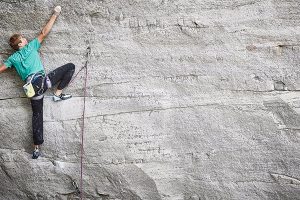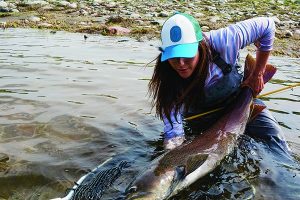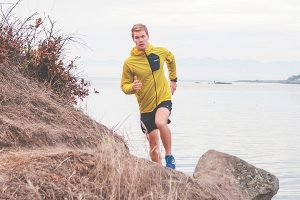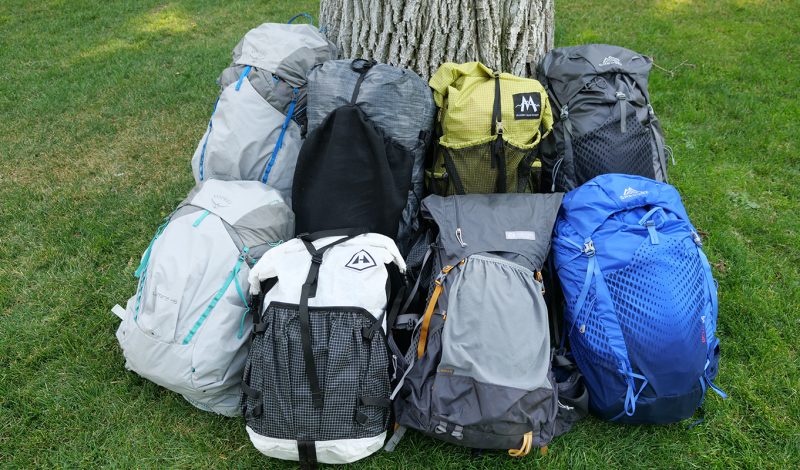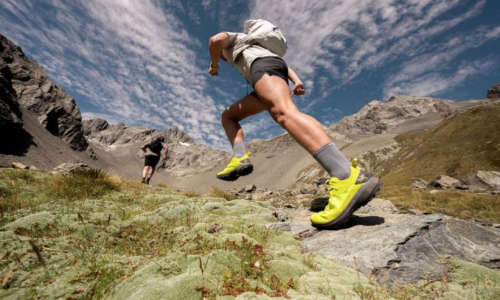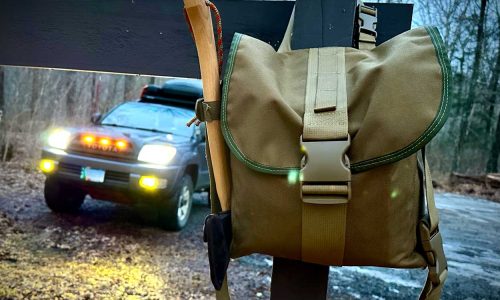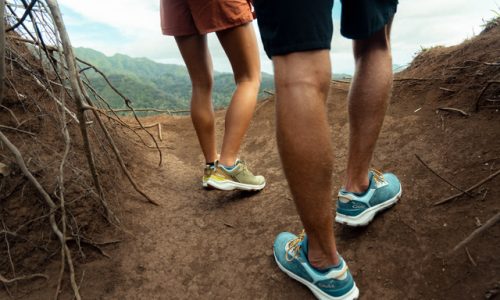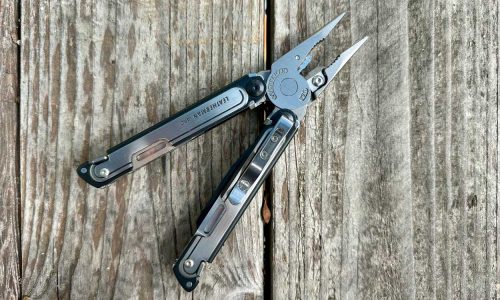During the past summer and fall, our testers were given the task of trying out a variety of ultralight packs on the market, from tried and true packs that have been available for years, to brand new offerings for this year. Ultralight backpacks make up an up and coming category that is more specific than other varieties of packs but still retains some versatility. Originally these packs were made for hikers doing months 20+mile days on routes such as the Appalachian Trail or the Pacific Crest Trail. The category now has evolved to include fastpackers and weekend warriors looking to maximize the mileage available to them in only a couple of days. As the number of people embarking on these treks has increased, so have the options for ultralight packs.
With so many new players in the world of ultralight packs, it was hard to narrow down the selection to even just 6 packs. However, testers tried out a variety of packs from old and young companies alike, including seasoned veteran backpack giants, Osprey and Gregory, as well as well-known dedicated ultralight brands, Gossamer Gear and Hyperlite Mountain Gear. Throw in customizable ultralight options from Katabatic Gear and Mountain Laurel Designs and our testers certainly had their hands full. Packs were tested in a variety of capacities between 40 liters and 60 liters, and when companies offered a gender-specific option, our testers made sure to try both male and female styles.
The main factor that sets ultralight packs apart from other packs on the market is that they are typically under 2 pounds and therefore tend to be less supportive under heavy loads and thus best suited for carrying weight under about 30 pounds. For a lot of people this type of pack is great for the casual fast-paced weekend trip, but for the dedicated backpacker, going ultralight can help keep the weight low for months on the trail, allowing for longer days and less fatigue. During the test, a variety of factors were taken into consideration to rank each pack, but the main considerations were broken down into weight, comfort, and features.
Best for Comfort
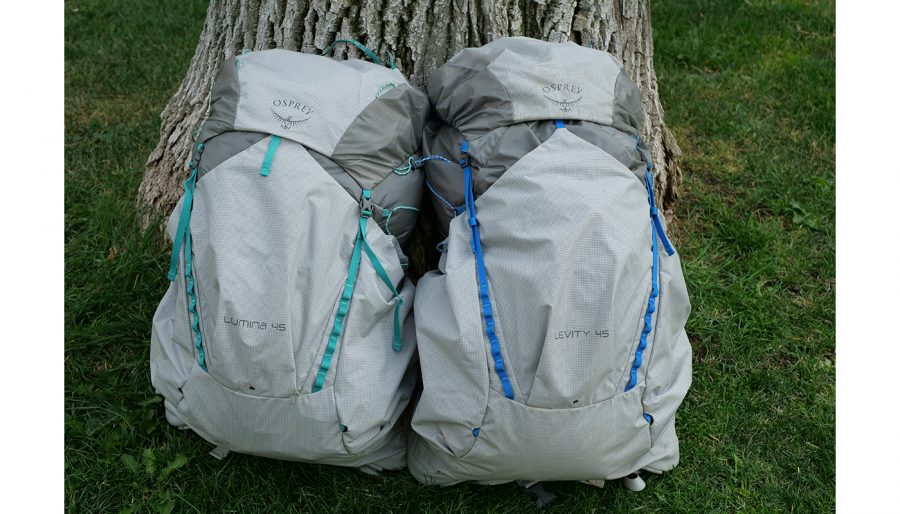 Osprey’s new Levity 45 (and the women’s specific counterpart, the Lumina 45) are proof that you can teach old dogs new tricks. Osprey has been in the pack game for nearly 50 years and has long been known for their durable, heavy-duty backpacking and day hiking options. Enter the Levity and Lumina 45, Osprey’s attempt to fly in the face of the dedicated ultralight crowd, and boy did they knock this one out of the park. Coming in a full twelve ounces lighter than Osprey’s previous ultralight offering, the Exos series, Osprey clearly brought their A-game when designing this pack.
Osprey’s new Levity 45 (and the women’s specific counterpart, the Lumina 45) are proof that you can teach old dogs new tricks. Osprey has been in the pack game for nearly 50 years and has long been known for their durable, heavy-duty backpacking and day hiking options. Enter the Levity and Lumina 45, Osprey’s attempt to fly in the face of the dedicated ultralight crowd, and boy did they knock this one out of the park. Coming in a full twelve ounces lighter than Osprey’s previous ultralight offering, the Exos series, Osprey clearly brought their A-game when designing this pack.
Utilizing a 3D tensioned mesh back panel, 3.5mm 6065 aluminum stay bar frame and a seamless mesh hipbelt and shoulder straps, the Levity and Lumina carry better than any other pack testers have ever worn, no matter the size. The mesh back panel keeps the pack “floating” off the wearer’s back by almost a full inch, allowing limitless breathability, and a contoured fit across the entire back. Combine this with Osprey’s NanoFly fabric made from Dyneema ripstop blended with Cordura Nylon and the pack becomes shockingly lightweight while maintaining an impressive level of durability. Testers were initially wary about the incredibly thin, almost flimsy feeling fabric, but once they started to throw the pack around a bit, realized that the durability of this pack is truly remarkable. In addition, the lifetime All Mighty Guarantee from Osprey only made them want to abuse the bag even more.
Among the favorite features of the pack are an attached zippered top lid, over-sized bellowed front pocket with enough space for more than one jacket, or even an entire wet tent, and dual access side water bottle pockets. If testers could find one complaint about the Levity/Lumina, it would have been the lack of hip belt pockets, though overall this was a very small concern. Another frustrating aspect of the design is that since the frame extends to the bottom of the pack, resulting in two points at the base of the pack that extends lower than the bag, the pack is unable to stand upright while packing or taking a break, and will fall over easily. The Levity pack series comes in 45- and 60-liter option and is available in a women’s specific fit, an otherwise identical pack called the Lumina, also available in 45- and 60-liter versions.
MSRP for the Levity or Lumina 45 is $250 with the 60L version for $270.
Best for Going the Distance
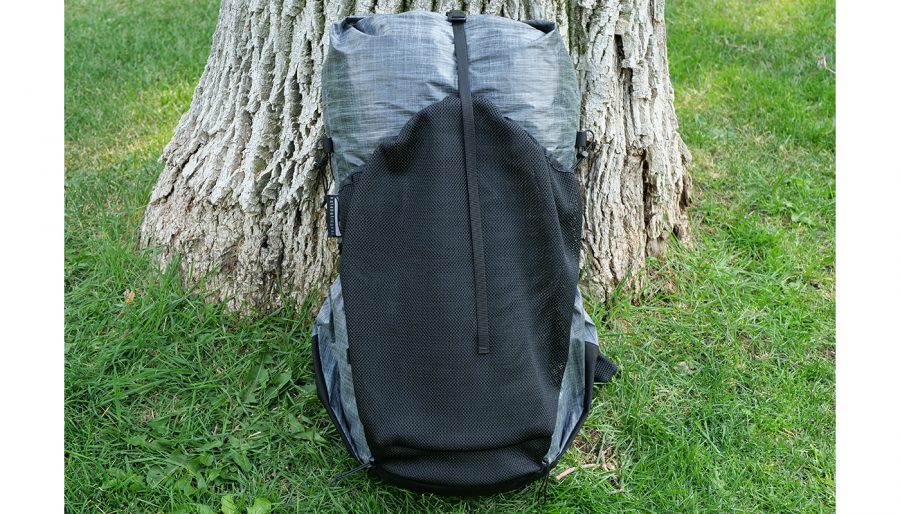 Katabatic Gear was started by a guy who was looking for innovations in sleeping bags after realizing the market was inundated with bulky equipment made from heavy materials. With Katabatic’s entry into the ultralight backpacking scene, they have been making quality bags to rival other well-established ultralight brands. Testers tried out the new Onni LiteSkin 65L pack which definitely punches above its weight class, with a higher carrying capacity than any of the other packs in this test while still coming it at only 1 lb, 12 oz.
Katabatic Gear was started by a guy who was looking for innovations in sleeping bags after realizing the market was inundated with bulky equipment made from heavy materials. With Katabatic’s entry into the ultralight backpacking scene, they have been making quality bags to rival other well-established ultralight brands. Testers tried out the new Onni LiteSkin 65L pack which definitely punches above its weight class, with a higher carrying capacity than any of the other packs in this test while still coming it at only 1 lb, 12 oz.
While the Onni pack comes in two fabric options, we opted to test their newest version made with LiteSkin fabric that is abrasion and water resistant (the fabric itself is waterproof, but without taped seams, the bag cannot claim full waterproof status). This pack uses the traditional roll top design that has a standard buckle closure but additionally uses a magnetic closure rather than a Velcro closure to help keep the bag sealed. The Onni uses a ventilated back panel with a full frame sheet and removable aluminum stay that is both lightweight and structurally sound giving the bag enough of a backbone to easily sit up on its own. The back panel and shoulder straps are comprised of a mesh fabric covering a ribbed foam pad that provides enough space for airflow, which helped keep all but the sweatiest of testers cool and comfortable during testing.
As is typical of an ultralight pack, the Onni LiteSkin has three exterior pockets that add an additional 14 liters of carrying capacity to the 54 liters in the main body. Testers liked the side water bottle pockets which were easy to reach without going through the trouble of taking off the pack. The large rear mesh pocket has plenty of room for wet clothing and any additional gear that won’t otherwise fit inside the pack. There is also the option to add stretchy mesh hip pockets, the largest in the test, which are big enough for a headlamp, snacks or a phone. The suggested carrying weight for this pack, at 35 pounds, is the highest in our test, giving the seasoned ultralight thru-hiker more than enough room to work with. With its high-carrying-capacity yet lightweight and durable construction, testers were in agreement that this pack should be a serious contender for anyone looking to hike a long trail with minimal weight.
MSRP is $295 or $320 with hip pockets
Best for Durability
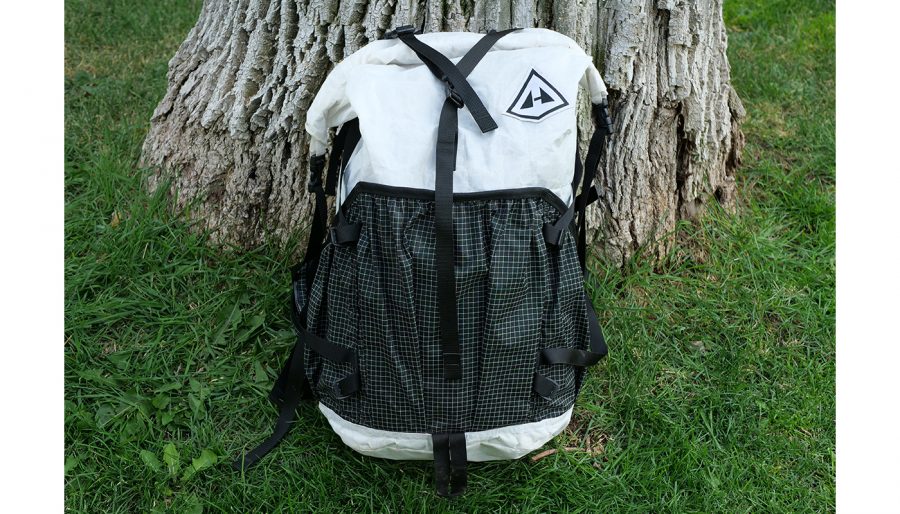 Hyperlite Mountain Gear is as close to a “household name” as you can get within the ultralight hiking community. The gold standard of ultralight, Hyperlight has been making packs specifically for the ultralight community for many years now. Starting with Cuben fabric (now called Dyneema Composite Fabric), Hyperlite redesigned the lightweight pack market by focusing on ultralight, ultra-durable materials with minimal frills. Hyperlite prides themselves on creating packs that have only the necessary features for fast and light expeditions where the user knows exactly what they need and doesn’t bring anything they don’t. Handmade in Maine, these packs are really a special piece of equipment. No ultralight pack comparison would be complete without including a piece from Hyperlite Mountain Gear.
Hyperlite Mountain Gear is as close to a “household name” as you can get within the ultralight hiking community. The gold standard of ultralight, Hyperlight has been making packs specifically for the ultralight community for many years now. Starting with Cuben fabric (now called Dyneema Composite Fabric), Hyperlite redesigned the lightweight pack market by focusing on ultralight, ultra-durable materials with minimal frills. Hyperlite prides themselves on creating packs that have only the necessary features for fast and light expeditions where the user knows exactly what they need and doesn’t bring anything they don’t. Handmade in Maine, these packs are really a special piece of equipment. No ultralight pack comparison would be complete without including a piece from Hyperlite Mountain Gear.
For our test, we tried the Hyperlite 2400 in the Southwest configuration. With three oversized solid Dyneema Hardline external pouch pockets, the Southwest configuration is built to carry moderate loads for long distances in rugged terrain. Made from seam-sealed Dyneema Composite Fabric, the roll-top closure bag is waterproof, durable and functional. Hyperlite’s no-frills approach to making gear shows here as the pack features are fairly minimal, but each one has its purpose. New for 2018, Hyperlite has decided to increase the size of the zippered hip belt pockets (a previous complaint made clear by many different reviews on their website). Our testers really enjoyed the increased capacity of the hip belt pockets, now with enough space for a headlamp, cell phone, keys, and spare room for a bar or two. Other features include a single ice axe loop, internal hydration sleeve, and a built-in hydration port, and a variety of well-placed compression straps to secure loads of various shapes and sizes.
The Hyperlite 2400 does include a removable frame made of two aluminum contoured stays and a ¼ inch foam back panel. When carrying the pack, testers really felt the pack was capable of being well balanced and comfortable with both large and small loads, up to 40 pounds. Breathability was better than most but still can’t hold a candle to the airy feeling of Osprey’s Levity 45 mesh back panel. The Hyperlite really stood out in durability. These things are tanks, and anyone would be hard pressed to damage a Hyperlite pack under normal use. Dyneema Composite Fabric, originally designed for use in sailboat racing sails, is comprised of flexible Dyneema fibers which are fifteen times stronger than steel. These fibers are then melded together to form a laminated puncture and tear resistant fabric that is also waterproof. Call it the quintessential backcountry fabric, a perfect balance of weight, durability, and waterproofness. Hyperlite uses Dyneema Composite Fabric is all of its packs and adds the even more durable Dyneema Hardline fabric in high wear areas, such as pockets, hip belt, and shoulder straps. Hyperlite packs are available in 2400, 3400 and 4400 cubic inch capacities, with four main external configurations. All other material details are the same and allow the buyer to choose exactly what carrying capacity they need.
MSRP on the 2400 Southwest is $310 with an additional $20 for the black color.
Best for Novice Ultralight hikers
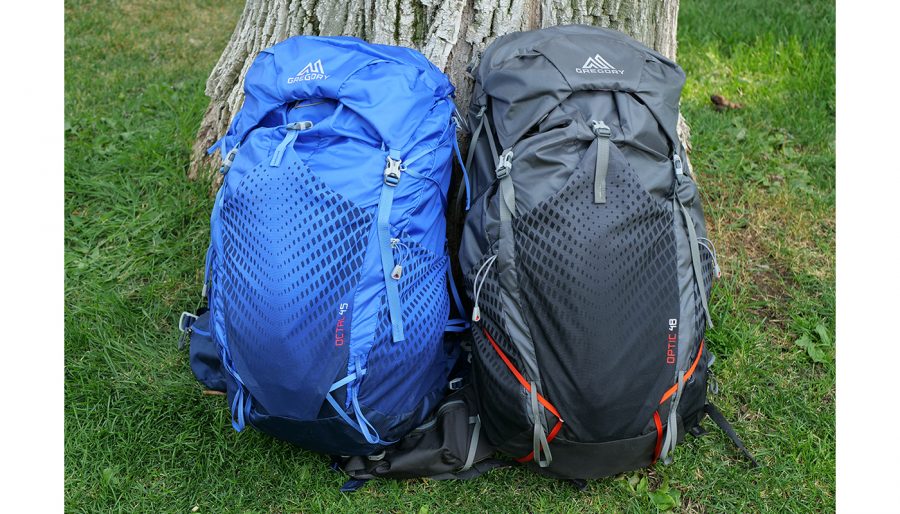 When looking for ultralight pack companies to test, Gregory was a bit of a surprise addition. A long-time contender in the traditional backpacking game, Gregory is perhaps best known for their feature-filled backpacking packs, more commonly seen on the backs of boy scouts and weekend warriors than the ultralight thru-hiking crowd. When Gregory released the Optic and Octal series, they were stepping up to the ultralight culture to bridge the gap between heavyweight weekenders and fast and light long hikers. After a summer spent hiking with the Optic and Octal, our testers believe they have done exactly that.
When looking for ultralight pack companies to test, Gregory was a bit of a surprise addition. A long-time contender in the traditional backpacking game, Gregory is perhaps best known for their feature-filled backpacking packs, more commonly seen on the backs of boy scouts and weekend warriors than the ultralight thru-hiking crowd. When Gregory released the Optic and Octal series, they were stepping up to the ultralight culture to bridge the gap between heavyweight weekenders and fast and light long hikers. After a summer spent hiking with the Optic and Octal, our testers believe they have done exactly that.
New for 2018, the men’s Optic 48 and women’s Octal 45 were the heaviest packs in our test, but still came in respectably at just under 40 ounces for the medium size, the lightest 40+liter packs Gregory has to offer. While the Optic and Octal might seem heavy by some ultralight standards, Gregory is really attempting to appeal to the consumer who likes the idea of an ultralight pack but doesn’t want to sacrifice comfort. We believe this pack fits squarely in the middle of the frameless fast and light sack, and the traditional feature-packed weekend backpacking packs. With a non-removable perimeter wired aluminum frame, and a floating mesh back panel, the Optic and Octal provided testers with all-day comfort under loads up to 40 pounds (well beyond the Gregory recommended weight of 30lbs.). This frame combines with an extremely comfortable ventilated dual-density foam hip belt and shoulder straps to allow the new ultralight hiker to still add a few extras to their bag as they make the transition to a more minimalist style of hiking without having to worry about sacrificing comfort on the trail. The frame/strap combo was also especially breathable, keeping testers comfortable and cool on hot days hiking uphill. Only the Osprey Levity and Lumina series were more breathable. Other favorable features include a removable lid with storage pocket that can be swapped out with the included ultra-light weather flap lid to keep the pack’s drawstring closure covered and protected from the elements. Also included are two dual zippered hip belt pockets, two ice ax/trekking pole loops, dual oversized mesh water bottle pockets, and an included rain cover.
All told, the Optic and Octal might not be the best option for the seasoned minimalist hiker and may very well not even land on their radar. However, this pack really should be a top contender for any veteran backpacker who is looking to start their transition toward ultralight hiking, while not wanting to sacrifice the comforts of their current 4+ pound pack. Testers also found this to be a great option for the first-time backpacker looking for a weekend pack but who is concerned about the overall weight of backpacking. A durable pack with enough of the “first timer” features to keep anyone happy, the Optic and Octal both are available in 48/45-liter sizing as well as a larger 58/55-liter offering for those looking to carry a bit more between resupplies. Another appealing factor to this pack is that investing in the Optic or Octal won’t break the bank. These were the least expensive pieces in our test with MSRP for both the Optic 48 and Octal 45 coming in at only $189.95.
Best for Gram Counters
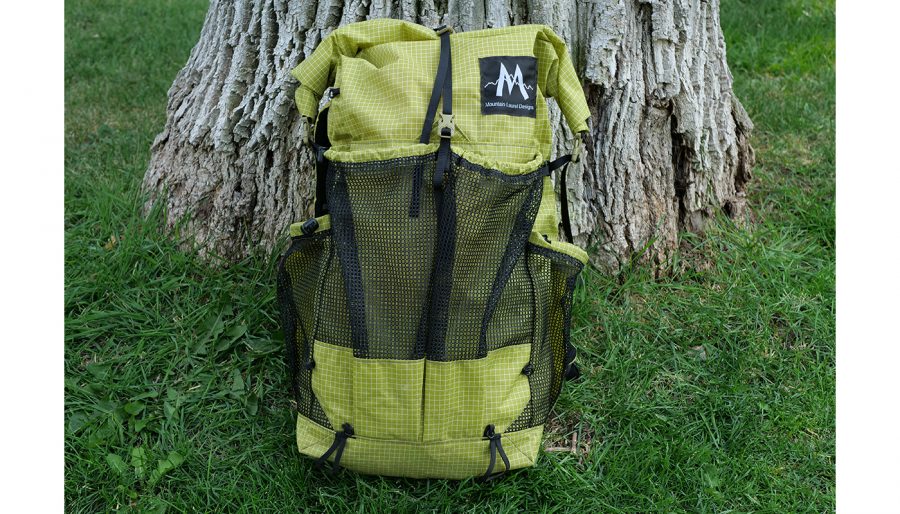 Testers were excited to get their hands on the newest version of Mountain Laurel Designs Exodus 57L pack. As a fairly well-known name in the ultralight community, this pack is best suited for experienced thru-hikers who enjoy a truly frameless pack but may want a few extra features that aren’t possible in the no-frills Hyperlite Mountain Gear packs. Mountain Laurel Designs utilized the same design in their previous award-winning Exodus pack and now make it in two versions, one with Dyneema X and the newest with the even lighter Dyneema Composite Fabric. With a similar philosophy to other smaller ultralight brands, Mountain Laurel Designs was started in 2002 by the founder Ron Bell who wanted to create simple and lightweight outdoor gear.
Testers were excited to get their hands on the newest version of Mountain Laurel Designs Exodus 57L pack. As a fairly well-known name in the ultralight community, this pack is best suited for experienced thru-hikers who enjoy a truly frameless pack but may want a few extra features that aren’t possible in the no-frills Hyperlite Mountain Gear packs. Mountain Laurel Designs utilized the same design in their previous award-winning Exodus pack and now make it in two versions, one with Dyneema X and the newest with the even lighter Dyneema Composite Fabric. With a similar philosophy to other smaller ultralight brands, Mountain Laurel Designs was started in 2002 by the founder Ron Bell who wanted to create simple and lightweight outdoor gear.
Testers were not disappointed by the latest iteration of the Exodus pack, which weighed in at only 1 pound when assembled with no extra features. It has a simple roll top design with an interior capacity of 40 liters. The extra 17 liters of capacity come into play with the two large side pockets and large back pocket. What testers really enjoyed about this pack is all the extra options for storage. This pack allows for a ton of customizability with the ability to add on a pack lid, either gear or bottle sized shoulder pockets or a hydration sleeve that converts into a small daypack and hip pockets. All of these extra features allow for tons of extra capacity while maintaining the simple design for those who want it.
Testers used the Exodus with pack weights greatly exceeding the 25-pound suggestion and still found it surprisingly comfortable. As to be expected from a frameless pack, there was a decent amount of pressure on the shoulders but for testers able to keep weight down to the suggested limit then this pack still carries great thanks to its padded waist belt and wider straps.
While most users new to the ultralight game may not love the feel of a frameless pack, those who are accustomed to and enjoy this style won’t find much to complain about in the Exodus. While choices abound, the biggest complaint about getting this pack may be deciding which extra features to spring for. At only $215 for the base pack, it’s a great price for a handmade frameless pack though of course that price quickly goes up when deciding to add on more features.
Best for Short Weekend Hikes
 Gossamer Gear is yet another small ultralight backpacking company that came about to create lightweight gear back before the ultralight scene really blew up. Gossamer creates packs in a variety of sizes with the Gorilla being in the middle between their 60-liter packs and their insanely lightweight 36L packs. Gossamer walks the line between having some padding for comfort while still utilizing minimal features to keep weight down. While the Gorilla feels like a frameless pack, it actually has a removable lightweight aluminum stay inside that provides a bit of structure at almost no weight. The removable foam pad which fit in a sleeve on the back of the pack represents another signature feature of Gossamer packs. This pad also doubles as a sit pad for around camp or under a sleeping mat for extra padding. The one downside of this design is that it was the least breathable of all the packs tested since there was a thick insulating foam pad right up against the back which prevented any airflow. Testers did find, however, that breathability improved with the removal of this pad, but not without sacrificing some comfort.
Gossamer Gear is yet another small ultralight backpacking company that came about to create lightweight gear back before the ultralight scene really blew up. Gossamer creates packs in a variety of sizes with the Gorilla being in the middle between their 60-liter packs and their insanely lightweight 36L packs. Gossamer walks the line between having some padding for comfort while still utilizing minimal features to keep weight down. While the Gorilla feels like a frameless pack, it actually has a removable lightweight aluminum stay inside that provides a bit of structure at almost no weight. The removable foam pad which fit in a sleeve on the back of the pack represents another signature feature of Gossamer packs. This pad also doubles as a sit pad for around camp or under a sleeping mat for extra padding. The one downside of this design is that it was the least breathable of all the packs tested since there was a thick insulating foam pad right up against the back which prevented any airflow. Testers did find, however, that breathability improved with the removal of this pad, but not without sacrificing some comfort.
The Gorilla has been updated to a unisex shoulder strap design that better fits both men and women. The waist belt and shoulder straps are also decently padded to make it a surprisingly comfortable pack for its ultralight design. Another thing we liked about this pack is that the suggested load weights go up to 30 pounds which would even be tough to achieve for a 40-liter pack. One complaint regarding the shoulder straps was that they are attached fairly close to each other, causing a pinching feeling on the neck for broad-shouldered testers. The pack uses a unique design of a buckle top closure instead of a roll top which allows for better utilization of space while still preventing water from entering with a small lid covering. Testers didn’t love this style of lid or closure due to the buckles being placed off-center, resulting in a design that was not very user-friendly. Their combination of a zippered lid and a roll-top closure still could use some work, but Gossamer seems to be the only brand trying to tackle this and testers are excited to see what they can come up with.
The Gorilla doesn’t have nearly the same level of customizability as the Mountain Laurel Designs Exodus but does have the option of adding on a hipbelt in three different sizes. It comes to some other features such as the internal hydration sleeve and their old-style lid covering with room for more gear that are additional costing features on the Mountain Laurel Designs pack. The rear mesh pocket was plenty big for additional gear or wet clothing and the two side water bottle pockets are easy to access without taking off the pack. With breathability being its main downfall, the Gorilla is a great pack for shorter weekend hikes or those thru hikers that really know how to pack well.
MSRP is $215 or $260 if adding on a set of hip belts.

